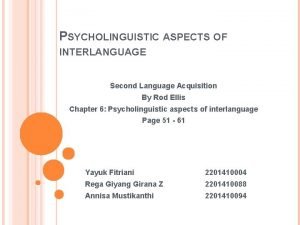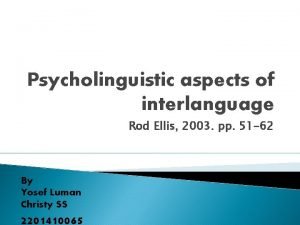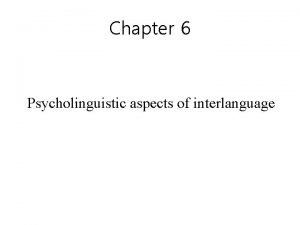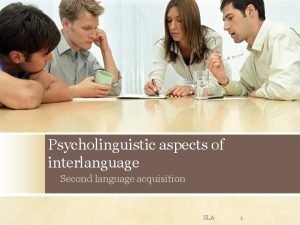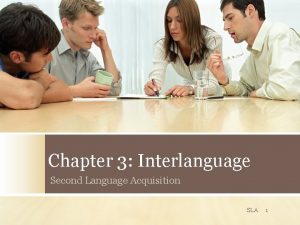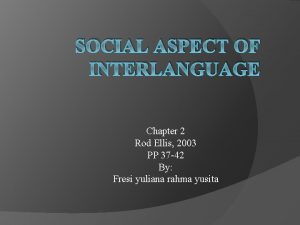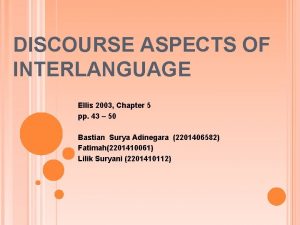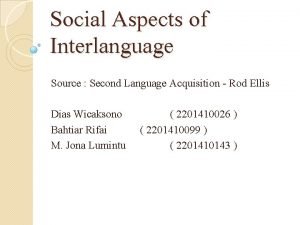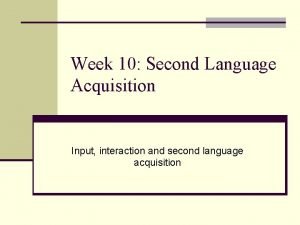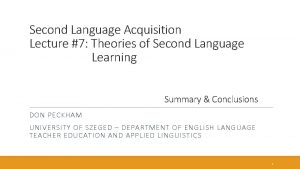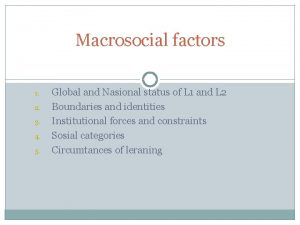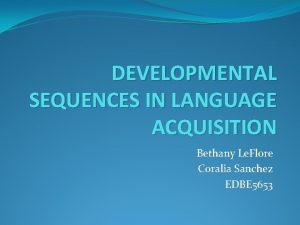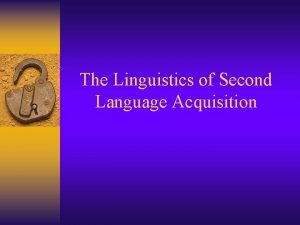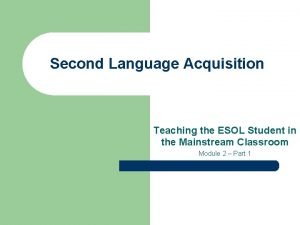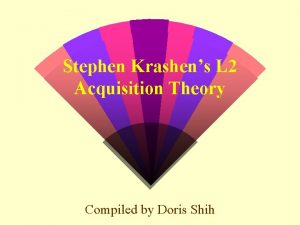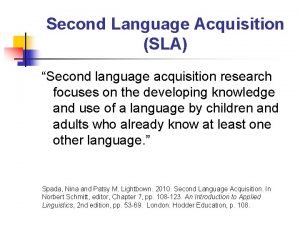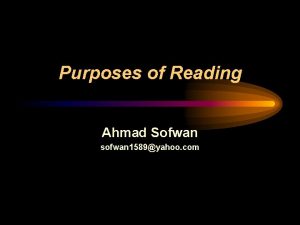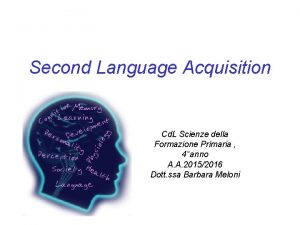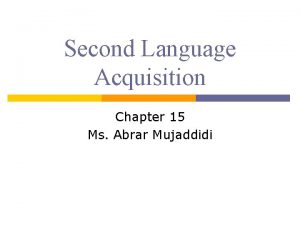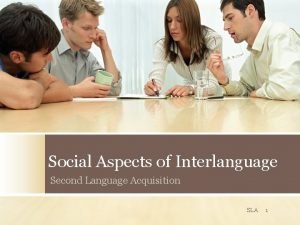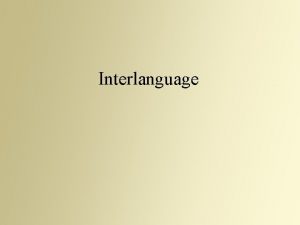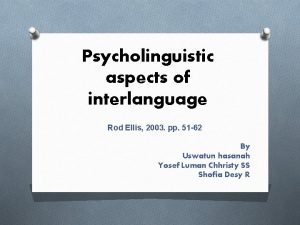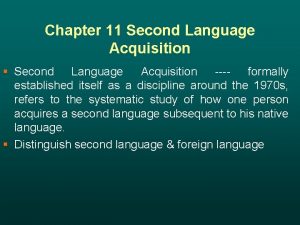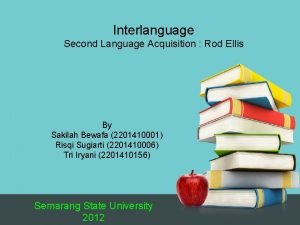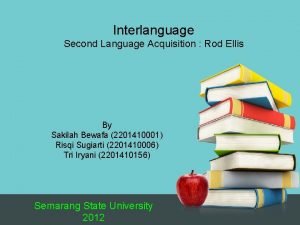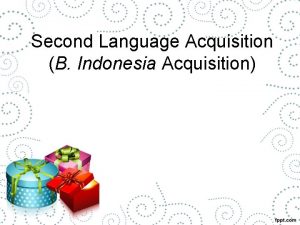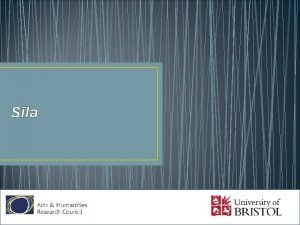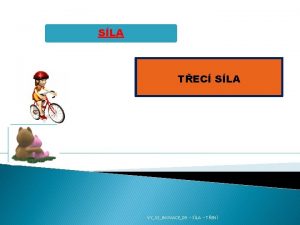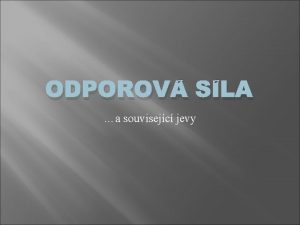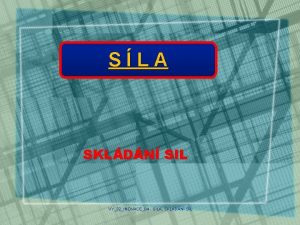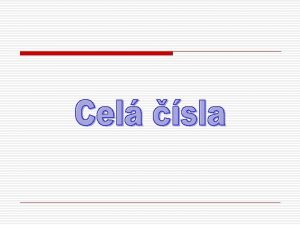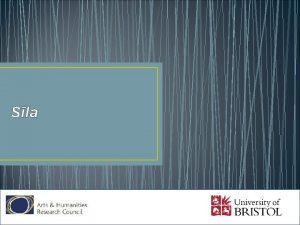Psycholinguistic aspects of interlanguage Second language acquisition SLA

























- Slides: 25

Psycholinguistic aspects of interlanguage Second language acquisition SLA 1

Psychology Psycholinguistics: The study of the mental structures and processes involved in language acquisition Linguistics

Psycholinguistic aspects • L 1 transfer • (Communication strategies)

L 1 Transfer

L 1 transfer L 1 influences 2020/9/29 L 2 SLA 5

Types of transfer Positive transfer • Where L 1 matches L 2 2020/9/29 Negative transfer (interference) • Where L 1 interferes with L 2 SLA 6

How does transfer affect L 2 speakers? Certain L 2 forms or structures are heavily or rarely used. Avoidance Overuse 2020/9/29 • Chinese speakers avoid the use of relative clauses. • Chinese speakers tend to overuse the expression of regret when apologizng in English. SLA 7

Mentalist view Cognitive view Behaviourist view language transfer

Contrastive analysis (behaviourist view) Similarities will facilitate L 2 learning Differences will result in learning difficulty L 1 vs. L 2. 2020/9/29 SLA 9

Problematic predictions: Differences do not always result in learning difficulty. 有 vs. have vs. there is/are 2020/9/29 Similarities: 有 vs. have Differences: 有 vs. there is/are EASY!! Difficult? ? SLA 10

Mentalist view To play down the role of L 1 Few errors are the result of L 1 transfer 2020/9/29 SLA 11

Cognitive view To reconceptualize transfer within (Larry Selinker) 2020/9/29 SLA 12

Cognitive view: To reconceptualize transfer within (Larry Selinker) language transfer is a cognitive process Learners draw on a variety of knowledge, including L 1, to form hypotheses. L 1 as a kind of ‘input from inside’. 2020/9/29 SLA 13

Cognitive constraints that govern L 1 transfer 2020/9/29 • Learners’ perception of what is transferable • Learners’ stage of development SLA 14

Learners’ perception of L 1 Learners have perceptions regarding the linguistic structure of L 1. They treat some as potentially transferable and others as potentially non-transferable. Hij brak zijn been. ‘He Het broke his leg. ’ ondergrondese verset werd gebroken. ‘The 2020/9/29 underground resistance was broken. ’ SLA 15

Stage of development As L 2 proficiency develops, learners may try to use some linguistic structures that accord with L 1 norms. Evident in invitation, refusal, etc. Proficient Japanese English speakers use high degree of formality required in Japanese 2020/9/29 SLA 16

What follows? Interlanguage development cannot constitute a restructuring continuum L 2 does not come from L 1, and L 2 does not replace L 1. Learners construct their interim rules (i. e. interlanguage) 2020/9/29 SLA 17

The role of consciousness Krashen: • learning vs. acquisition 2020/9/29 Schmidt • Intentionality vs. attention SLA 18

Learning vs. acquisition Learning • Conscious study of L 2 • Formal settings Acquisition • Subconsciously developed • Naturalistic settings Two independent systems learned knowledge cannot be converted into acquired knowledge. 2020/9/29 SLA 19

intentionality vs. attention intentionality • Whether a learner makes a conscious and deliberate decision to learn some L 2 knowledge. Attention • Noticing (the process of attending consciously to linguistic features in the input) Awareness (implicit knowledge) • Whether learners are conscious of acquiring new L 2 elements 2020/9/29 SLA 20

Consciousness (2) Implicit vs. explicit knowledge Are learners capable of learning explicit knowledge? Yes No May explicit knowledge help learners develop implicit knowledge? 2020/9/29 SLA 21

Computational models Serial processing 2020/9/29 Parallel distributed processing SLA 22

Computing as playing piano http: //www. bgfl. org/bgfl/custom/resources_ftp /client_ftp/ks 2/music/piano/

Serial processing Information is processed one at a time in a certain sequence. A C B

Parallel distributed processing 2020/9/29 the representation of information is distributed (not local) memory and knowledge for specific things are not stored explicitly, but stored in the connections between units. learning can occur with gradual changes in connection strength by experience SLA 25
 Psycholinguistics aspects of interlanguage
Psycholinguistics aspects of interlanguage Rod ellis 2003
Rod ellis 2003 Psycholinguistic aspects of interlanguage
Psycholinguistic aspects of interlanguage Psycholinguistic aspects of interlanguage
Psycholinguistic aspects of interlanguage Second language vs foreign language
Second language vs foreign language Interlanguage continuum
Interlanguage continuum Interlanguage and social identity and investment
Interlanguage and social identity and investment Interlanguage and stylistic continuum
Interlanguage and stylistic continuum Social and discourse aspects of interlanguage
Social and discourse aspects of interlanguage Undelies
Undelies Nativization model example
Nativization model example Input and interaction in second language acquisition
Input and interaction in second language acquisition Slidetodoc.com
Slidetodoc.com 7 theories of second language acquisition
7 theories of second language acquisition Macrosocial factors in second language acquisition
Macrosocial factors in second language acquisition Developmental sequence linguistics
Developmental sequence linguistics Second language acquisition questions
Second language acquisition questions Cummins model of second language acquisition
Cummins model of second language acquisition Compare and contrast first and second language acquisition
Compare and contrast first and second language acquisition Krashens theory
Krashens theory Second language acquisition
Second language acquisition Contrastive analysis
Contrastive analysis Ayon kay goodman ang pagbasa ay isang
Ayon kay goodman ang pagbasa ay isang Psycholinguistic guessing game
Psycholinguistic guessing game Language learning with youtube
Language learning with youtube Difference between second language and foreign language
Difference between second language and foreign language
